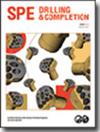从Robertson微分代数方程问题的角度探讨提高气涌模拟算法效率的自动化流入管理
IF 1.2
4区 工程技术
Q3 ENGINEERING, PETROLEUM
引用次数: 6
摘要
在配备控压钻井(MPD)系统的井中,提高模拟井筒气侵行为的数值效率对于实现基于模型预测的实时气侵管理至关重要。目前,大多数高保真多相流模型的求解算法耗时大,不适合实时决策和控制。在模型预测控制器(MPCs)的应用中,计算时间长会导致超调量大,控制效率低。本文提出了一种基于漂移通量模型(DFM)的气侵模拟器,采用了一种新颖的数值格式来提高计算效率。本文采用微分代数方程(DAEs)形式的Robertson问题求解算法作为DFM控制方程的数值解法。比较分析了该数值格式与目前广泛采用的通量分裂方法的数值稳定性和计算效率。结果表明,与平流-上游分裂混合方法(AUSMV)相比,Robertson DAE方法在保持相同的预报精度的同时,显著减少了总运算次数和计算时间。根据“大o符号”分析,Robertson DAE方法显示出计算复杂度的低阶增长,证明了其在提高数值效率方面的良好潜力,特别是在处理更大规模的模拟时。利用水基泥浆(WBM)测试井的实测数据,验证了这两种数值方案对DFM求解的有效性。该研究为DFM提供了一种新的数值解决方案,可以显着减少气涌模拟所需的计算时间,同时保持较高的预测精度。这种方法可以将高保真的两相流模型应用于基于模型预测的决策制定和MPD系统的自动化流入管理。本文章由计算机程序翻译,如有差异,请以英文原文为准。
On Improving Algorithm Efficiency of Gas-Kick Simulations toward Automated Influx Management: A Robertson Differential-Algebraic-Equation Problem Approach
Improved numerical efficiency in simulating wellbore gas-influx behaviors is essential for realizing real-time model-prediction-based gas-influx management in wells equipped with managed-pressure-drilling (MPD) systems. Currently, most solution algorithms for high-fidelitymultiphase-flow models are highly time consuming and are not suitable for real-time decision making and control. In the application of model-predictive controllers (MPCs), long calculation time can lead to large overshoots and low control efficiency.
This paper presents a drift-flux-model (DFM)-based gas-influx simulator with a novel numerical scheme for improved computational efficiency. The solution algorithm to a Robertson problem as differential algebraic equations (DAEs) was used as the numerical scheme to solve the control equations of the DFM in this study. The numerical stability and computational efficiency of this numerical scheme and the widely used flux-splitting methods are compared and analyzed. Results show that the Robertson DAE problem approach significantly reduces the total number of arithmetic operations and the computational time compared with the hybrid advection-upstream-splitting method (AUSMV) while maintaining the same prediction accuracy. According to the “Big-O notation” analysis, the Robertson DAE approach shows a lower-order growth of computational complexity, proving its good potential in enhancing numerical efficiency, especially when handling simulations with larger scales. The validation of both the numerical schemes for the solution of the DFM was performed using measured data from a test well drilled with water-based mud (WBM).
This study offers a novel numerical solution to the DFM that can significantly reduce the computational time required for gas-kick simulation while maintaining high prediction accuracy. This approach enables the application of high-fidelity two-phase-flow models in model-prediction-based decision making and automated influx management with MPD systems.
求助全文
通过发布文献求助,成功后即可免费获取论文全文。
去求助
来源期刊

SPE Drilling & Completion
工程技术-工程:石油
CiteScore
4.20
自引率
7.10%
发文量
29
审稿时长
6-12 weeks
期刊介绍:
Covers horizontal and directional drilling, drilling fluids, bit technology, sand control, perforating, cementing, well control, completions and drilling operations.
 求助内容:
求助内容: 应助结果提醒方式:
应助结果提醒方式:


